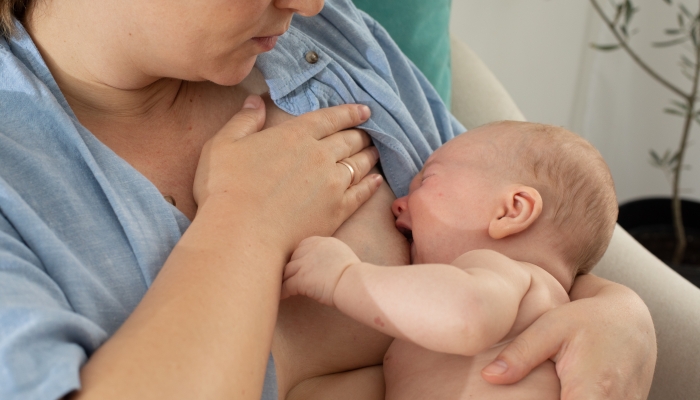Slacker Boob? When One Breast Isn’t Producing Enough Milk

- A slacker boob is fairly common and usually is not a cause for concern.
- Knowing the stages of breast milk production can help you tell if you should be concerned.
- Use a breast pump to encourage a greater milk supply.
Do any of these sound familiar to you?
“I don’t have enough milk because my baby eats all the time.”
“How can I make more milk?”
“One breast gives less milk than the other when I pump. What’s wrong with me?”
Or:
“One breast is a super milk maker, and the other is my slacker boob. What’s going on? How can I make my ‘lazy’ boob produce more milk?”
As a nurse working with babies and their mothers, I sometimes see situations where mothers experience greater milk production in one breast than the other. This is where I first heard the term “slacker” boob and worked with mothers struggling to produce enough breast milk to give their children.
It’s a heart-rending scenario and can lead to mothers feeling frustrated and discouraged. Fortunately, there are many ways to fix a slacker boob and encourage your milk supply in both breasts.
What is a Slacker Boob?
A “slacker boob” is a general term used to describe a situation where a breastfeeding mother has an uneven milk supply.
To put it another way, one breast doesn’t produce as much milk as the other.
While it’s normal to have slight variation between the supply in each breast, a slacker boob generally makes noticeably less than the other side.
How to Tell if you Have a Slacker Boob
Before you resign yourself to having a slacker boob, it’s important to establish a timeframe to help you determine whether or not there’s a problem with your breast milk production.

Transitional Milk
Generally speaking, a mother’s transitional milk supply arrives two to five days after delivery and can last until 10–14 days after birth. Signs that your body is producing transitional milk are:
- Your breasts have increased in size and fullness.
- More frequent swallowing from your baby while breastfeeding because of the larger volume.
- Letdown from the other breast while nursing on the first side.
- A tingly or “pins-and-needles” feeling while breastfeeding your baby.
Though these signs are typically present within two weeks after the birth of your little one, some mothers take longer to make transitional milk, and that’s totally normal too.
Mature Milk
A mother’s mature milk is usually considered to be the milk that is present from fourteen days after delivery to the end of your breastfeeding journey.
Mature milk generally has the same nutritional composition as transitional milk but may differ in appearance.
Many mothers in this period notice a bluish tint to their breast milk at the beginning of a pumping session. This watery portion provides the necessary volume and nutrients to your baby when nursing.
The thicker portion, called hindmilk, comes toward the end of the breastfeeding or pumping session. It’s creamy, high in fat, and helps keep your baby full between feedings.
Time for Concern?
If your baby is more than three weeks old and there is a notable lack of changes in the size, feeling, or amount of milk expressed from your breasts, it is time to contact your doctor or a lactation consultant for evaluation of your milk production.
Chances are, you will likely suspect there’s a problem with your supply before three weeks have passed. If your baby isn’t gaining weight as expected or is showing signs of dehydration, your child’s doctor will suggest exploring your body’s ability to make breast milk sooner.
Reasons Why You Have a Slacker Boob
Breastfeeding is all about correct and adequate stimulation of your breasts to make milk. Remember that a mother’s body makes breast milk as a complex interplay between the baby’s mouth (or your pump) and the stimulation of the breast tissue that sends the message to a mother’s brain to make milk.
When that signal isn’t fully received or not received at all, you can wind up with one breast producing less milk than the other.
Slacker boobs can be the result of issues such as:
Shallow or poor latch.
A shallow latch is when the baby latches to the tip or part of the nipple instead of getting all the nipple into their mouth.
In addition to not receiving a full signal to make milk, many mothers experience nipple trauma or skin breakdown as a result of an improper latch.
You may note that your nipple resembles a new tube of lipstick after your baby has been latched and suckling for a while. This can be another indication that your baby has not been latching correctly.
Poor breastfeeding positioning.
Have you noticed that your baby latches and unlatches often during breastfeeding? This could signal that your little one is attempting to fix a positioning problem.
Always using the same breast at the beginning.
Many lactation consultants recommend alternating which breast is offered at the beginning of a nursing session.
In general, the first side offered is the “main course” because the baby is more hungry at the beginning of the session. The second side becomes “dessert”.
Just like you don’t always eat dessert after your meal, your baby doesn’t either. Long-term use of making one breast “the meal” and the other side “dessert” can lead to lopsided breasts and an uneven milk supply.
Prior breast surgery.
If you’ve had breast surgery (like reduction or augmentation), disruption or removal of the breast tissue can affect a mother’s ability to make milk.
Removing and repositioning the nipple as part of these surgeries is of particular concern in the possible development of a slacker boob.
Consider contacting a lactation consultant if this situation applies to you.

Should You Worry About Having a Slacker Boob?
Though it may sound rare and like a cause for concern, having an under producing breast isn’t all that unusual and is considered completely normal.
However, it’s time to call your doctor if:
- Your development of a slacker boob is sudden.
- The slacker boob shows signs of mastitis.
- You can feel a large, palpable lump in your breast, with or without signs of illness.
There may be a medical reason that one breast produces less than expected.
When Should You Not Worry About Having a Slacker Boob?
At times, your slacker side will simply have a lower supply than the other breast, without an obvious reason. Though this can be frustrating for a mother and make you feel self conscious, it’s not a problem for your baby.
If your little one is still having enough wet and dirty diapers and gaining weight, having one side that produces less can be considered part of your unique breastfeeding journey.
Helpful Ways to Increase Milk Supply in a Slacker Boob
Remember a day or two after delivery and your new baby was cluster feeding for the first time? Remember how you felt like there was something wrong with you or your baby because they were eating so often?
Cluster feeding is the natural process an infant uses to tell a mother’s body to make more milk.
When faced with a slacker boob, the main idea behind increasing the milk supply is to mimic cluster feeding. Extra stimulation of the side that has a lower supply will hopefully increase the amount of milk made in that breast.
So, what can you do on your own to fix a slacker boob?
Begin with the Basics
In this time of adjusting to the birth of your little one and finding a new normal in your family, it’s easy to let some of the basics go. When determining if you need to increase supply, first make sure you’re:
- Sleeping. Your body repairs itself when you sleep. Staying awake when your body says rest will divert its energies to activities other than making breast milk.
- Eating enough. Though breastfeeding can help you lose weight, you also need to eat enough (roughly 500 extra calories a day through healthy snacks). Restricting calories will tell your body to enter a starvation state, which further impacts breast milk production.
- Drinking non-caffeinated liquids. Did you know that breasts are modified sweat glands? Dehydration also restricts milk output. Listen to your body and drink to thirst each day. Make sure you limit caffeine, as it will further reduce your production.
Add Heat
Try adding a warm compress to your slacker boob while your baby nurses to increase milk flow, or consider a hot shower just before feeding. Breast compression or gentle massage while nursing may also be extremely helpful.
Pump
There are a few ways to boost an uneven supply with a breast pump and tell the slacker side to make more milk.
You can try:
- Letting your baby start eating on the side that makes less. Once they’ve finished nursing, use your pump to empty the first breast, then keep pumping for a few minutes more. Most breastfeeding specialists recommend extra pumping should last for for 5—10 minutes.
- Longer pumping on the slacker boob. Once you finish pumping on both breasts during a normal pumping session, keep going for another five minutes or so on the slacker side only.
- Single pump. Consider adding a few extra pumping times throughout the day on the slacker boob only.
- Power pump. Power pumping is an option only if you can’t make enough breast milk on your own. Talk with a lactation consultant to see if power pumping is a good fit for you.
All of these methods use the pump to trigger multiple letdowns in your slacker boob, which will tell your brain to increase supply and make more breast milk. You should start noticing results in a few days to a couple weeks.
Breastfeeding and pumping are a labor of love. There’s no question that the extra time and effort spent addressing a slacker boob can be frustrating and discouraging. However, feeding your child breast milk is a significant investment in their long-term health. Ultimately, it is work worth doing.

The information WonderBaby provides is not intended to be, and does not constitute, medical or other health advice or diagnosis and should not be used as such. Always consult with a qualified medical professional about your specific circumstances.
Related Posts

Breastfeeding, Sleep
Sleep and Breastfeeding: A Comprehensive Guide for Nursing Moms
Many people assume breastfeeding and sleep training don’t go together, but it is possible to help your baby sleep better while continuing your breastfeeding journey.

Breastfeeding
Comfort Nursing: Pros, Cons, and How to Stop
Find out what comfort nursing is, when should you worry about it, and how to stop or limit your baby's comfort nursing (especially at night!).

Breastfeeding, Product Reviews
5 Best Breastfeeding Chairs for Nursing Moms of 2023
Whether you want a gentle rock, a smooth glide, or a cozy cuddle to soothe your baby to sleep, you’ll have your pick of the best breastfeeding chairs on the...